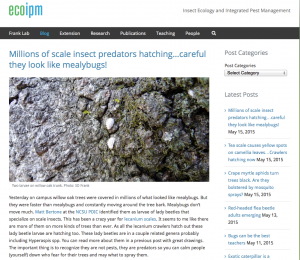Spider Mite Outbreaks
Originally posted on ecoIPM.org Things are heating up and the twospotted spider mite, Tetranychus urticae, thrives in hot dry weather. …


El inglés es el idioma de control de esta página. En la medida en que haya algún conflicto entre la traducción al inglés y la traducción, el inglés prevalece.
Al hacer clic en el enlace de traducción se activa un servicio de traducción gratuito para convertir la página al español. Al igual que con cualquier traducción por Internet, la conversión no es sensible al contexto y puede que no traduzca el texto en su significado original. NC State Extension no garantiza la exactitud del texto traducido. Por favor, tenga en cuenta que algunas aplicaciones y/o servicios pueden no funcionar como se espera cuando se traducen.
Inglês é o idioma de controle desta página. Na medida que haja algum conflito entre o texto original em Inglês e a tradução, o Inglês prevalece.
Ao clicar no link de tradução, um serviço gratuito de tradução será ativado para converter a página para o Português. Como em qualquer tradução pela internet, a conversão não é sensivel ao contexto e pode não ocorrer a tradução para o significado orginal. O serviço de Extensão da Carolina do Norte (NC State Extension) não garante a exatidão do texto traduzido. Por favor, observe que algumas funções ou serviços podem não funcionar como esperado após a tradução.
English is the controlling language of this page. To the extent there is any conflict between the English text and the translation, English controls.
Clicking on the translation link activates a free translation service to convert the page to Spanish. As with any Internet translation, the conversion is not context-sensitive and may not translate the text to its original meaning. NC State Extension does not guarantee the accuracy of the translated text. Please note that some applications and/or services may not function as expected when translated.
Collapse ▲Originally posted on ecoIPM.org Things are heating up and the twospotted spider mite, Tetranychus urticae, thrives in hot dry weather. …
Originally posted on ecoIPM.org It seems like everything is labeled ‘next generation’ or ‘second generation’ to imply a better, more …
Originally posted on ecoIPM.org I was in Northwestern Pennsylvania last week and found tulip poplar trees with leaves that had …
8/22/2022 – Interest in bloodroot is greater than ever! 6/23/2015 – Margaret and I have been getting many inquiries about …

8/16/2022 – Update. This article was posted over seven years ago, but the event is still my favorite and …

8/17/2022 – I wrote this post in 2015. Interesting to see what we were doing then and what has …
Hibiscus sawfly, Atomacera decepta, is a common pest of hibiscus. Not much is known about this critter from what I …
Originally posted on ecoIPM.org… You can often see hoverflies zipping in and out of flowers in your garden. They approach …
Lace bugs have been out most of the summer but the damage is becoming apparent now as populations grow. …
This week I found cottony camellia scale ovisacs on hollies in my yard and on campus. Cottony camellia scale, …
If you see ragged holes in leaves with no pest in site you may have slugs. Slugs thrive in …
This week Cliff Ruth told me they were finding red headed flea beetle adults and larvae in mountain nurseries. …
This week did not find many ambrosia beetles in our traps this week (there will always be a few) …
If you have conifers or other plants that seem to have grown weird, dangling pinecones, look again because you …
The Daylily leafminer is a recent pest from Asia. It was first detected in 2006 but has now spread …

If you like NC Pest News you might like the ecoipm blog. I use the blog to post information …

8/15/2022 – Update. Almost seven years have passed since Margaret wrote this article. She is now a research associate …

8/4/2022 – The post below was written in 2015. This project is going through 2022. Be sure to look …

Update 8/25/2022 – Original article: 12/9/2020 – This is an old article, but every bit as relevant today and …

7/9/2022 – I wrote the article below almost eight years ago because I received some “push back” for my …

Establishing and maintaining quality annual color beds requires a plan to prevent and control weeds. …

This publication describes the invasive Callery pear species, its offspring, and how it can harm …
This factsheet describes the biology of the cane lace bug or bamboo lace bug, Leptodictya …

This factsheet describes the biology of the banded sphinx moth or lesser vine sphinx, Eumorpha …

This factsheet describes the biology of the elm-grass root aphid, Tetraneura ulmi, and provides residential …
This publication for homeowners and landscapers describes how to mow, fertilize, irrigate, and control weeds …

A muscadine virus survey was conducted in 2024 to assess the incidence of grapevine viruses …

This publication reports the results of an annual survey of sod growers in North Carolina …